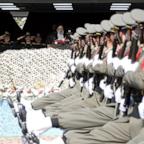US Navy Blue Angels Prepare to Soar Again
After a year on hiatus, the elite aviation daredevils are back.
March 15, 2014— -- For Lt. Commander Dave Tickle and the other five demo pilots, performing plunging dives and barrel rolls in an F/A-18 fighter jet with hairpin precision above a cheering crowd is all in a day's work.
They are the U.S. Navy Blue Angels, an elite aviation team that performs daredevil stunts with wing tips as close as 18 inches apart, as spectators watch below.
The Blue Angels have been out of action for a year due to budget cuts, but are making a comeback this year. The team's 2014 debut is today at Naval Air Facility (NAF) in El Centro, Calif., where a crowd of between 35,000 and 50,000 people are expected.
Ahead of their first show, "Nightline" was granted rare access to fly with the demonstration pilots during their final days of winter training.
Stay tuned to watch the full story on "Nightline" next week at 12:35 a.m. ET
The Blue Angels train together six days a week, two or three times a day, both in the gym and in the air -- for years -- each time pushing the envelope as they screech through the air in jets that costs $30 million each.
"We take our physical conditioning very seriously," Lt. Commander Tickle said. "Working out six days a week is no joke."
These men are picked for their skill and calm-under-pressure attitudes. Every Blue Angel pilot is selected by U.S. Navy operational fleet forces and all come from operational squadrons.
Lt. Commander Tickle was chosen from dozens of pilots to be a Blue Angel demo-pilot. Married with one child and another one on the way, Tickle is now in his fourth season with the team. He has a total flight time of over 2,000 flight hours.
"We do it so much that we're not nervous about it," Lt. Commander Tickle said. "Day after day, exact same things, so we're very comfortable doing it knowing that we always have that margin of safety."
His fellow pilots include No. 2 Right Wing Pilot, Lt. Commander John Hiltz, 34, now in his third year as a Blue Angel, and No. 3 Left Wing Pilot, Lt. Commander Nate Barton, who has a wife and three kids. Others include Captain Brandon Cordill and Lt. Mark Tedrow. Navy Commander Thomas Frosch, as known as "Boss," leads the team.
"It's all about inspiring kids," Frosch said. "I was inspired as a 6-year-old. ... It made me say, 'I don't understand the military as a 6-year-old but I want to do that,' and our goal is to inspire a culture of excellence and service to the country."
The team's key to perfection is practice. Each flier is required to put on 120 practice demos before they are ready to do a full show. The squadron trains in the desert to sift out any potential errors that could occur and every flight is crucial. A doctor is on base when the Blue Angels are training and said he watches to see if the nose of a plane starts to dip, which could indicate that the pilot is losing or has lost consciousness.
"They're flying sometimes only at 50 feet and so going unconscious just for a millisecond or a second can be detrimental or catastrophic," said Lt. Commander Mark DeBuse, the flight surgeon for the Blue Angels.
The aircraft are capable of soaring up to 30,000 feet in less than a minute, flying at speeds of over 800 miles per hour in just 30 seconds. The risks are incredibly high. Twenty six pilots have died since the Blue Angels were formed almost 70 years ago, giving this job a 10 percent fatality rate.




